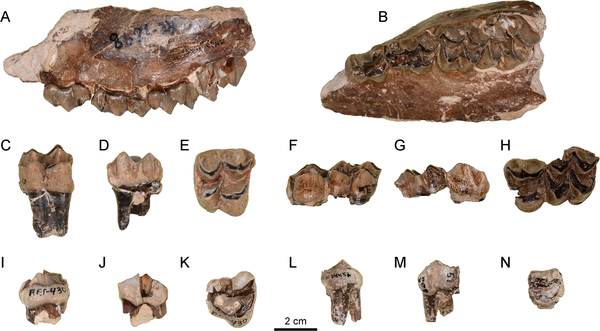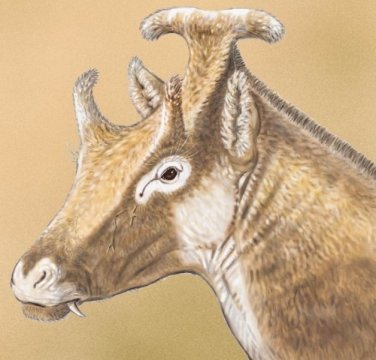The extinct three-horned palaeomerycid ruminant, Xenokeryx amidalae, found in Spain, may be from the same clade as giraffes, according to a study published December 2, 2015 in the open-access journal PLOS ONE by Israel M. Sánchez from the Museo Nacional de Ciencias Naturales-CSIC, Madrid, Spain, and colleagues.

Cranial remains of Xenokeryx amidalae gen. et sp. nov. from La Retama.
A, MNCN-74448 (holotype), occipital appendage in anterior view; B, MNCN-74448 (holotype), occipital appendage in lateral view; C, MNCN-74448 (holotype), occipital appendage in posterior view; D, MNCN-74449, right ossicone and supra-orbital region of a skull in latero-distal view; E, MNCN-74449, right ossicone and supra-orbital region of the skull in medial view; F, MNCN-74446, left juvenile ossicone and supra-orbital region of the skull in lateral view; G, MNCN-74446, left juvenile ossicone and supra-orbital region of the skull in medial view; H, MNCN-74447, left juvenile ossicone in apical view, showing its transversal section; I, MNCN-74449, detail of the ossicone-frontal bone contact showing the suture line (not to scale). Abbreviations: Bp, bumps; Nf, nuchal fossa; Ow, ossicone ‘wing’; Sl, suture line between ossicone and frontal bone.

Upper dentition remains of Xenokeryx amidalae gen. et. sp. nov. from La Retama.
A, MNCN-74495, left maxillar with DP2-M1 in buccal view; B, MNCN-74495, left maxillar with DP2-M1 in occlusal view; C, MNCN-74452, right M3 in lingual view; D, MNCN-74452, right M3 in buccal view; E, MNCN-74452, right M3 in occlusal view; F, MNCN-74450, left P4-M1 in lingual view; G, MNCN-74450, left P4-M1 in buccal view; H, MNCN-74450, left P4-M1 in occlusal view; I, MNCN-74451, right P3 in lingual view; J, MNCN-74451, right P3 in buccal view; K, MNCN-74451, right P3 in occlusal view; L, MNCN-74453, right P2 in buccal view; M, MNCN-74453, right P2 in lingual view; N, MNCN-74453, right P2 in occlusal view.
Palaeomerycids, now extinct, were strange three-horned Eurasian Miocene ruminants known through fossils from Spain to China. In this article, the authors classify the palaeomerycid to their clade based on shared characteristics with the best-known species of the group and reassess their phylogenetic position among ruminants, which is currently disputed. The authors use well-preserved remains of a new palaeomerycid, Xenokeryx amidalae, which included a complete sample of cranial–including both frontal and supra-occipital ‘t-shaped’ cranial appendages–dental, and postcranial remains, from middle Miocene deposits of Spain.
The authors found that despite their apparent external similarities, Eurasian palaeomerycids are not closely related to North American dromomerycids, distant relatives to deer, as some scientists have thought. Instead, palaeomerycids are in the clade Giraffomorpha, the least inclusive clade containing Giraffa and Triceromeryx. The authors conclude that future ruminant research will benefit from more in-depth analysis, such as phylogenetic analysis combining fossil and living taxa, morphological and molecular datasets, and fossil ages.
Israel Sánchez adds: “Establishing the place of palaeomerycids in the ruminant tree gives us insights into the evolutionary history of the large clade of pecoran ruminants that include giraffes (Giraffa and Okapia) as its only extant survivors, and shows us the amazing diversity of an ancient lineage that inhabited both Eurasia and Africa.”
Citation:PLOS. “Extinct 3-horned palaeomerycid ruminant found in Spain: Extinct new species with ‘t-shaped’ horn may be relative of giraffes.” ScienceDaily. ScienceDaily, 2 December 2015.
Key: WFS,Riffin T Sajeev,Russel T Sajeev,World Fossil Society



 December 8th, 2015
December 8th, 2015  Riffin
Riffin 
 Posted in
Posted in  Tags:
Tags: 